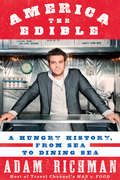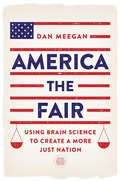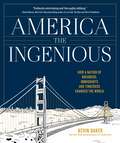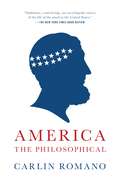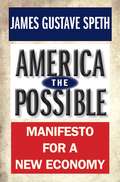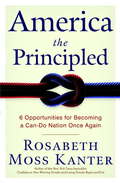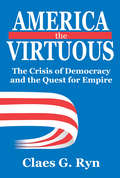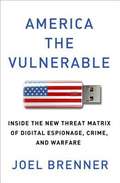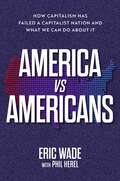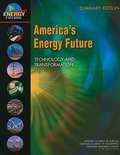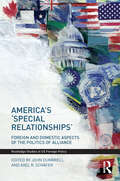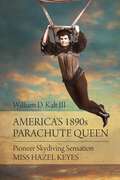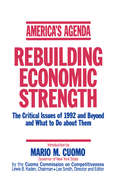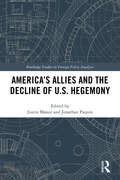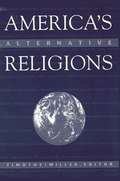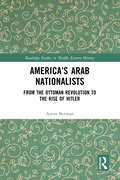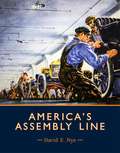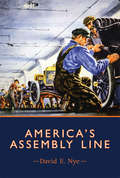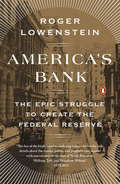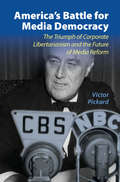- Table View
- List View
America the Edible: A Hungry History, from Sea to Dining Sea
by Adam RichmanGet ready to devour America. Adam Richman, the exuberant host of Travel Channel's Man v. Food and Man v. Food Nation, has made it his business to root out unique dining experiences from coast to coast. Now, he zeroes in on some of his top-favorite cities—from Portland, Maine, to Savannah, Georgia—to share his uproariously entertaining food travel stories, top finds, and some invaluable (and hilarious) cautionary tales. America the Edible also tells the story behind the menu, revealing the little-known reason why San Francisco's sourdough bread couldn't exist without San Francisco's fog; why Cleveland just might have some of the country's best Asian cuisine; and how to eat like a native on the Hawaiian island of Oahu. Unflaggingly funny, curious, and, of course, hungry, Richman captures the spectacular melting pot of American cuisine as only a true foodie and insatiable storyteller can.
America the Fair: Using Brain Science to Create a More Just Nation
by Dan MeeganWhat makes a person liberal or conservative? Why does the Democratic Party scare off so many possible supporters? When does our "injustice trigger" get pulled, and how can fairness overcome our human need to look for a zero-sum outcome to our political battles?Tapping into a pop culture zeitgeist linking Bugs Bunny, Taylor Swift, and John Belushi; through popular science and the human brain; to our political predilections, arguments, and distrusts, Daniel Meegan suggests that fairness and equality are key elements missing in today's society. Having crossed the border to take up residency in Canada, Meegan, an American citizen, has seen first-hand how people enjoy as rights what Americans view as privileges. Fascinated with this tension, he suggests that American liberals are just missing the point. If progressives want to win the vote, they need to change strategy completely and champion government benefits for everyone, not just those of lower income. If everyone has access to inexpensive quality health care, open and extensive parental leave, and free postsecondary education, then everyone will be happier and society will be fair. The Left will also overcome an argument of the Right that successfully, though incongruously, appeals to the middle- and upper-middle classes: that policies that help the economically disadvantaged are inherently bad for others. Making society fair and equal, Meegan argues, would strengthen the moral and political position of the Democratic Party and place it in a position to revive American civic life. Fairness, he writes, should be selfishly enjoyed by everyone.
America the Ingenious: How a Nation of Dreamers, Immigrants, and Tinkerers Changed the World
by Kevin Baker“Among the many rewards of America the Ingenious, Kevin Baker’s survey of Yankee know-how, is stumbling on its buried nuggets. . . . Baker examines a wide range of the achievements that have made, and still make, America great again—and again.” —The Wall Street Journal All made in America: The skyscraper and subway car. The telephone and telegraph. The safety elevator and safety pin. Plus the microprocessor, amusement park, MRI, supermarket, Pennsylvania rifle, and Tennessee Valley Authority. Not to mention the city of Chicago or jazz or that magnificent Golden Gate Bridge. What is it about America that makes it a nation of inventors, tinkerers, researchers, and adventurers—obsessive pursuers of the never-before-created? And, equally, what is it that makes America such a fertile place to explore, discover, and launch the next big thing? In America the Ingenious, bestselling author Kevin Baker brings his gift of storytelling and eye for historical detail to the grand, and grandly entertaining, tale of American innovation. Here are the Edisons and Bells and Carnegies, and the stories of how they followed their passions and changed our world. And also the less celebrated, like Jacob Youphes and Loeb Strauss, two Jewish immigrants from Germany who transformed the way at least half the world now dresses (hint: Levi Strauss). And Leo Fender, who couldn’t play a note of music, midwifing rock ’n’ roll through his solid-body electric guitar and amplifier. And the many women who weren’t legally recognized as inventors, but who created things to make their lives easier that we use every day—like Josephine Cochran, inventor of the dishwasher, or Marion O’Brien Donovan, who invented a waterproof diaper cover. Or a guy with the improbable name of Philo Farnsworth, who, with his invention of television, upended communication as significantly as Gutenberg did. At a time when America struggles with different visions of what it wants to be, America the Ingenious shows the extraordinary power of what works: how immigration leads to innovation, what a strong government and strong public education mean to a climate of positive practical change, and why taking the long view instead of looking for short-term gain pays off many times over, not only for investors and inventors, but for the rest of us whose lives are made better by the new. America and its nation of immigrants have excelled at taking ideas from anywhere and transforming them into the startling, often unexpectedly beautiful creations that have shaped our world. This is that story.
America the Philosophical
by Carlin RomanoA bold, insightful book that rejects the myth of America the Unphilosophical, arguing that America today towers as the most philosophical culture in the history of the world, an unprecedented marketplace of truth and argument that far surpasses ancient Greece or any other place one can name. With verve and keen intelligence, Carlin Romano--Pulitzer Prize finalist, award-winning book critic, and professor of philosophy--takes on the widely held belief that ours is an anti-intellectual society. Instead, while providing a richly reported overview of American thought, Romano argues that ordinary Americans see through phony philosophical justifications faster than anyone else, and that the best of our thinkers abandon artificial academic debates for fresh intellectual enterprises, such as cyberphilosophy. Along the way, Romano seeks to topple philosophy's most fiercely admired hero, Socrates, asserting that it is Isocrates, the nearly forgotten Greek philosopher who rejected certainty, whom Americans should honor as their intellectual ancestor. America the Philosophical introduces readers to a nation whose existence most still doubt: a dynamic, deeply stimulating network of people and places drawn together by shared excitement about ideas. From the annual conference of the American Philosophical Association, where scholars tack wiseguy notes addressed to Spinoza on a public bulletin board, to the eruption of philosophy blogs where participants discuss everything from pedagogy to the philosophy of science to the nature of agency and free will, Romano reveals a world where public debate and intellectual engagement never stop. And readers meet the men and women whose ideas have helped shape American life over the previous few centuries, from well-known historical figures like William James and Ralph Waldo Emerson, to modern cultural critics who deserve to be seen as thinkers (Kenneth Burke, Edward Said), to the iconoclastic African American, women, Native American, and gay mavericks (Cornel West, Susan Sontag, Anne Waters, Richard Mohr) who have broadened the boundaries of American philosophy. Smart and provocative, America the Philosophical is a rebellious tour de force that both celebrates our country's unparalleled intellectual energy and promises to bury some of our most hidebound cultural clichés.
America the Possible: Manifesto for a New Economy
by James Gustave SpethIn this third volume of his award-winning American Crisis series, James Gustave Speth makes his boldest and most ambitious contribution yet. He looks unsparingly at the sea of troubles in which the United States now finds itself, charts a course through the discouragement and despair commonly felt today, and envisions what he calls America the Possible, an attractive and plausible future that we can still realize. The book identifies a dozen features of the American political economy—the country's basic operating system—where transformative change is essential. It spells out the specific changes that are needed to move toward a new political economy—one in which the true priority is to sustain people and planet. Supported by a compelling "theory of change" that explains how system change can come to America, the book also presents a vision of political, social, and economic life in a renewed America. Speth envisions a future that will be well worth fighting for. In short, this is a book about the American future and the strong possibility that we yet have it in ourselves to use our freedom and our democracy in powerful ways to create something fine, a reborn America, for our children and grandchildren.
America the Principled
by Rosabeth Moss KanterKanter details six ways to restore America's strengths by returning to open-society principles, viewing this society as one that "invests in people and new ideas, rewards talent and hard work, values dialogue and learns from dissent, operates to high standards with transparent information, looks for common ground, sees problems as opportunities for creative change, and encourages those who are fortunate to help others. " She discusses how America needs to spread innovation and the opportunity to participate in the economic revolution of the twenty-first century, and have a new social contract based on real family values and fair and flexible workplaces attentive to families and women. She also argues for values-based capitalism and responsible companies, government as an instrument of public interest, engagement with the world and other countries, and a community of caring. Kanter (strategy, innovation, and leadership for change, Harvard Business School) has advised CEOs of large and small companies and is the author of several books. Annotation ©2008 Book News, Inc. , Portland, OR (booknews. com)
America the Virtuous: The Crisis of Democracy and the Quest for Empire
by Clase G. RynUrged on by a powerful ideological and political movement, George W. Bush committed the United States to a quest for empire. American values and principles were universal, he asserted, and should guide the transformation of the world. Claes Ryn sees this drive for virtuous empire as the triumph of forces that in the last several decades acquired decisive influence in both the American parties, the foreign policy establishment, and the media.Public intellectuals like William Bennett, Charles Krauthammer, William Kristol, Michael Novak, Richard Perle, and Norman Podhoretz argued that the United States was an exceptional nation and should bring "democracy," "freedom," and "capitalism" to countries not yet enjoying them. Ryn finds the ideology of American empire strongly reminiscent of the French Jacobinism of the eighteenth century. He describes the drive for armed world hegemony as part of a larger ideological whole that both expresses and aggravates a crisis of democracy and, more generally, of American and Western civilization. America the Virtuous sees the new Jacobinism as symptomatic of America shedding an older sense of the need for restraints on power. Checks provided by the US Constitution have been greatly weakened with the erosion of traditional moral and other culture.
America the Vulnerable
by Joel BrennerA former top-level National Security Agency insider goes behind the headlines to explore America's next great battleground: digital security. An urgent wake-up call that identifies our foes; unveils their methods; and charts the dire consequences for government, business, and individuals. Shortly after 9/11, Joel Brenner entered the inner sanctum of American espionage, first as the inspector general of the National Security Agency, then as the head of counterintelligence for the director of national intelligence. He saw at close range the battleground on which our adversaries are now attacking us-cyberspace. We are at the mercy of a new generation of spies who operate remotely from China, the Middle East, Russia, even France, among many other places. These operatives have already shown their ability to penetrate our power plants, steal our latest submarine technology, rob our banks, and invade the Pentagon's secret communications systems. Incidents like the WikiLeaks posting of secret U. S. State Department cables hint at the urgency of this problem, but they hardly reveal its extent or its danger. Our government and corporations are a "glass house," all but transparent to our adversaries. Counterfeit computer chips have found their way into our fighter aircraft; the Chinese stole a new radar system that the navy spent billions to develop; our own soldiers used intentionally corrupted thumb drives to download classified intel from laptops in Iraq. And much more. Dispatches from the corporate world are just as dire. In 2008, hackers lifted customer files from the Royal Bank of Scotland and used them to withdraw $9 million in half an hour from ATMs in the United States, Britain, and Canada. If that was a traditional heist, it would be counted as one of the largest in history. Worldwide, corporations lose on average $5 million worth of intellectual property apiece annually, and big companies lose many times that. The structure and culture of the Internet favor spies over governments and corporations, and hackers over privacy, and we've done little to alter that balance. Brenner draws on his extraordinary background to show how to right this imbalance and bring to cyberspace the freedom, accountability, and security we expect elsewhere in our lives. In America the Vulnerable, Brenner offers a chilling and revelatory appraisal of the new faces of war and espionage-virtual battles with dangerous implications for government, business, and all of us. .
America the Vulnerable: How Our Government is Failing to Protect Us Against Terrorism
by Stephen FlynnIn this powerful and urgently needed call to action, national security expert Stephen Flynn offers a startling portrait of the radical shortcomings in America's plan for homeland security. He describes a frightening scenario of what the next major terrorist attack might look like -- revealing the tragic loss of life and economic havoc it would leave in its wake, as well as the seismic political consequences it would have in Washington. Flynn also shows us how to prepare for such a disaster, outlining a bold yet practical plan for achieving security in a way that is safe and smart, effective and manageable.In this new world of heightened risk and fear, America the Vulnerable delivers a timely, forceful message that cannot be ignored.
America vs. Americans: How Capitalism Has Failed a Capitalist Nation and What We Can Do About It
by Eric WadeIn America vs. Americans, Eric Wade presents American Laborism, a revolutionary new economic system, where the greatest commodity isn&’t cash, it&’s work.Capitalism is broken. Despite its successes, capitalism gives us the largest wealth gap in American history, failing Social Security, a weak currency, and a looming threat of AI destroying our workforce. We need a new system—one built around people rather than capital. A system that values each person&’s unique contribution, ingenuity, and hard work—their labor. A system in which the greatest commodity isn&’t cash; it&’s work. And a system in which Americans at every level of society and government are working together. We need American Laborism, a revolutionary new system that presents a workable, low-tax form of capitalism for those who want it—and a dignified, healthy, happy, and fulfilled life for everyone else. Under American Laborism, if you&’re happy with the current capitalist system, great! Carry on—but you&’ll get to do it with a smaller government, fewer regulations, better-educated employees, and lower taxes. And if capitalism hasn&’t worked out as well for you, you get access to unlimited free education and training, guaranteed housing and food, and a sound asset-backed currency. Everybody wins! American Laborism isn&’t just a replacement for capitalism. It&’s an upgrade. Every American has the right to live a life of dignity, to contribute, and to ensure that their basic needs are respected by their society. American Laborism can improve the lives of every American by bringing the least among us up . . . without bringing anyone else down. It&’s time to heal our nation. It&’s time for American Laborism.
America! Jesus Is Here!
by Mel Tari Cliff DudleyMel Tari because of the daring of Like a Mighty Wind is in suspect by many people. There are those who praise him and those who curse the day he was born. Now Mel brings you messages from God on the simplicity of the Word, Christ's return, spiritual growth, and the command for the baptism of love.Jesus is alive and doing great and mighty things among His people - listen to the cry of Mel Tari, America, Jesus is Here!
America'S Energy Future: Technology and Transformation - Summary Edition
by National Academy of Science National Academy of Enegineering National Research Council of the National AcademiesEnergy touches our lives in countless ways and its costs are felt when we fill up at the gas pump, pay our home heating bills, and keep businesses both large and small running. There are long-term costs as well: to the environment, as natural resources are depleted and pollution contributes to global climate change, and to national security and independence, as many of the world's current energy sources are increasingly concentrated in geopolitically unstable regions. The country's challenge is to develop an energy portfolio that addresses these concerns while still providing sufficient, affordable energy reserves for the nation. The United States has enormous resources to put behind solutions to this energy challenge; the dilemma is to identify which solutions are the right ones. Before deciding which energy technologies to develop, and on what timeline, we need to understand them better. The summary edition of America's Energy Future summarizes the full analyses of the potential of a wide range of technologies for generation, distribution, and conservation of energy found in the complete edition of America's Energy Future. This summary edition also succinctly considers technologies to increase energy efficiency, coal-fired power generation, nuclear power, renewable energy, oil and natural gas, and alternative transportation fuels. It assesses the associated impacts and projected costs of implementing each technology and categorizes them into three time frames for implementation.
America's 'Special Relationships': Foreign and Domestic Aspects of the Politics of Alliance (Routledge Studies in US Foreign Policy)
by Axel R. Schäfer John DumbrellThis unique volume offers an original collection of essays on the theme of America’s ‘special relationships’. It interrogates in an original and provocative manner the distinctive character of America’s interactions with an array of allies and clients, both international and domestic. The essays vary in their focus; some are primarily historical, some are more contemporary. All consider the quality of ‘specialness’ in the context of America’s relationship with particular countries, including the United Kingdom, Canada, Australia, New Zealand, Holland, Russia, Iran and Israel. The collection also concerns the relationship between the American state and key ‘special’ foreign policy interests, notably ethnic lobbies and religious groups. Bringing together a wide range of experts, this timely collection provides a valuable addition to the debates surrounding US foreign policy, and will be of great interest to students and scholars of American politics, American history and international relations.
America's 1890s Parachute Queen: Pioneer Skydiving Sensation Miss Hazel Keyes
by William III KaltDeath-defying skydiver Miss Hazel Keyes thrills thousands as she leaps from her balloon with her monkey, Miss Jennie Yan Yan. Sail through the heavens with this robust, spunky woman as she earns nationwide fame for more than a decade. Miss Hazel’s life af
America's Agenda: Rebuilding Economic Strength
by Mario M. Cuomo The Cuomo Commission on CompetitivenessCuomo's Commission on Competitiveness argues that America must reform its economic and social policies and institutions to reverse the weakening of its industrial leadership, the erosion of living standards and escalating social problems. Topics include public investment, urban poverty, health care, the environment, fiscal policy and international strategies.
America's Allies and the Decline of US Hegemony (Routledge Studies in Foreign Policy Analysis)
by Jonathan Paquin Justin MassieHow do America’s democratic allies perceive and respond to a relative decline in US power and influence and the simultaneous rise of China? Using the case-studies of Europe, the UK, Australia, Canada, Japan and South East Asian countries, this book offers a broad assessment of the perceptions of threat and the strategies used by these allies to cope with the relative decline of America’s hegemonic power, the rise of China and the transforming world order. In answering these central questions, contributors focus on two complementary analytical approaches. The first examines the perceptions of systemic changes by America’s allies: how are US allies framing this issue and what kind of political discourse is emerging with regards to it? The second approach focuses on the concrete foreign policy and defence strategies put forward by these allies. The book explores the extent to which US allies are willing to support US hegemony and considers the democratic allies’ understanding of the international structure, their relations to the United States, and their own aspirations in this changing world order. This book will be of interest to general readers as well as scholars and students of US foreign policy, foreign policy analysis and International Relations.
America's Alternative Religions (SUNY Series in Religious Studies)
by Timothy MillerThis is a single-volume source of reliable information on the most important alternative religions, covering for each such essentials as history, theology, impact on the culture, and current status. The chapters of the book were written by experts who study the movements they have written about.
America's Arab Nationalists: From the Ottoman Revolution to the Rise of Hitler (Routledge Studies in Middle Eastern History)
by Aaron BermanAmerica’s Arab Nationalists focuses in on the relationship between Arab nationalists and Americans in the struggle for independence in an era when idealistic Americans could see the Arab nationalist struggle as an expression of their own values. In the first three decades of the twentieth century (from the 1908 Ottoman revolution to the rise of Hitler), important and influential Americans, including members of the small Arab-American community, intellectually, politically and financially participated in the construction of Arab nationalism. This book tells the story of a diverse group of people whose contributions are largely unknown to the American public. The role Americans played in the development of Arab nationalism has been largely unexplored by historians, making this an important and original contribution to scholarship. This volume is of great interest to students and academics in the field, though the narrative style is accessible to anoyone interested in Arab nationalism, the conflict between Zionists and Palestinians, and the United States’ relationship with the Arab world.
America's Asia: Racial Form and American Literature, 1893-1945
by Colleen LyeWhat explains the perception of Asians both as economic exemplars and as threats? America's Asia explores a discursive tradition that affiliates the East with modern efficiency, in contrast to more familiar primitivist forms of Orientalism. Colleen Lye traces the American stereotype of Asians as a "model minority" or a "yellow peril"--two aspects of what she calls "Asiatic racial form"-- to emergent responses to globalization beginning in California in the late nineteenth century, when industrialization proceeded in tandem with the nation's neocolonial expansion beyond its continental frontier. From Progressive efforts to regulate corporate monopoly to New Deal contentions with the crisis of the Great Depression, a particular racial mode of social redress explains why turn-of-the-century radicals and reformers united around Asian exclusion and why Japanese American internment during World War II was a liberal initiative. In Lye's reconstructed archive of Asian American racialization, literary naturalism and its conventions of representing capitalist abstraction provide key historiographical evidence. Arguing for the profound influence of literature on policymaking, America's Asia examines the relationship between Jack London and leading Progressive George Kennan on U.S.-Japan relations, Frank Norris and AFL leader Samuel Gompers on cheap immigrant labor, Pearl S. Buck and journalist Edgar Snow on the Popular Front in China, and John Steinbeck and left intellectual Carey McWilliams on Japanese American internment. Lye's materialist approach to the construction of race succeeds in locating racialization as part of a wider ideological pattern and in distinguishing between its different, and sometimes opposing, historical effects.
America's Assembly Line
by David E. NyeThe assembly line was invented in 1913 and has been in continuous operation eversince. It is the most familiar form of mass production. Both praised as a boon to workers andcondemned for exploiting them, it has been celebrated and satirized. (We can still picture Chaplin'slittle tramp trying to keep up with a factory conveyor belt. ) In America's AssemblyLine, David Nye examines the industrial innovation that made the United States productiveand wealthy in the twentieth century. The assembly line -- developed at the FordMotor Company in 1913 for the mass production of Model Ts -- first created and then served anexpanding mass market. It inspired fiction, paintings, photographs, comedy, cafeteria layouts, andcookie-cutter suburban housing. It also transformed industrial labor and provoked strikes and uniondrives. During World War II and the Cold War, it was often seen as a bastion of liberty andcapitalism. By 1980, Japan had reinvented the assembly line as a system of "leanmanufacturing"; American industry reluctantly adopted this new approach. Nye describes thisevolution and the new global landscape of increasingly automated factories, with fewer industrialjobs in America and questionable working conditions in developing countries. A century after Ford'spioneering innovation, the assembly line continues to evolve toward more sustainablemanufacturing.
America's Assembly Line
by David E. NyeFrom the Model T to today's "lean manufacturing": the assembly line as crucial, yet controversial, agent of social and economic transformation.The mechanized assembly line was invented in 1913 and has been in continuous operation ever since. It is the most familiar form of mass production. Both praised as a boon to workers and condemned for exploiting them, it has been celebrated and satirized. (We can still picture Chaplin's little tramp trying to keep up with a factory conveyor belt.) In America's Assembly Line, David Nye examines the industrial innovation that made the United States productive and wealthy in the twentieth century.The assembly line—developed at the Ford Motor Company in 1913 for the mass production of Model Ts—first created and then served an expanding mass market. It also transformed industrial labor. By 1980, Japan had reinvented the assembly line as a system of “lean manufacturing”; American industry reluctantly adopted the new approach. Nye describes this evolution and the new global landscape of increasingly automated factories, with fewer industrial jobs in America and questionable working conditions in developing countries. A century after Ford's pioneering innovation, the assembly line continues to evolve toward more sustainable manufacturing.
America's Bank
by Roger LowensteinA tour de force of historical reportage, America's Bank illuminates the tumultuous era and remarkable personalities that spurred the unlikely birth of America's modern central bank, the Federal Reserve. Today, the Fed is the bedrock of the financial landscape, yet the fight to create it was so protracted and divisive that it seems a small miracle that it was ever established. For nearly a century, America, alone among developed nations, refused to consider any central or organizing agency in its financial system. Americans' mistrust of big government and of big banks--a legacy of the country's Jeffersonian, small-government traditions--was so widespread that modernizing reform was deemed impossible. Each bank was left to stand on its own, with no central reserve or lender of last resort. The real-world consequences of this chaotic and provincial system were frequent financial panics, bank runs, money shortages, and depressions. By the first decade of the twentieth century, it had become plain that the outmoded banking system was ill equipped to finance America's burgeoning industry. But political will for reform was lacking. It took an economic meltdown, a high-level tour of Europe, and--improbably--a conspiratorial effort by vilified captains of Wall Street to overcome popular resistance. Finally, in 1913, Congress conceived a federalist and quintessentially American solution to the conflict that had divided bankers, farmers, populists, and ordinary Americans, and enacted the landmark Federal Reserve Act.Roger Lowenstein--acclaimed financial journalist and bestselling author of When Genius Failed and The End of Wall Street--tells the drama-laden story of how America created the Federal Reserve, thereby taking its first steps onto the world stage as a global financial power. America's Bank showcases Lowenstein at his very finest: illuminating complex financial and political issues with striking clarity, infusing the debates of our past with all the gripping immediacy of today, and painting unforgettable portraits of Gilded Age bankers, presidents, and politicians.Lowenstein focuses on the four men at the heart of the struggle to create the Federal Reserve. These were Paul Warburg, a refined, German-born financier, recently relocated to New York, who was horrified by the primitive condition of America's finances; Rhode Island's Nelson W. Aldrich, the reigning power broker in the U.S. Senate and an archetypal Gilded Age legislator; Carter Glass, the ambitious, if then little-known, Virginia congressman who chaired the House Banking Committee at a crucial moment of political transition; and President Woodrow Wilson, the academician-turned-progressive-politician who forced Glass to reconcile his deep-seated differences with bankers and accept the principle (anathema to southern Democrats) of federal control. Weaving together a raucous era in American politics with a storied financial crisis and intrigue at the highest levels of Washington and Wall Street, Lowenstein brings the beginnings of one of the country's most crucial institutions to vivid and unforgettable life. Readers of this gripping historical narrative will wonder whether they're reading about one hundred years ago or the still-seething conflicts that mark our discussions of banking and politics today. From the Hardcover edition.
America's Bank: The Epic Struggle to Create the Federal Reserve
by Roger LowensteinA tour de force of historical reportage, America's Bank illuminates the tumultuous era and remarkable personalities that spurred the unlikely birth of America's modern central bank, the Federal Reserve. Today, the Fed is the bedrock of the financial landscape, yet the fight to create it was so protracted and divisive that it seems a small miracle that it was ever established. For nearly a century, America, alone among developed nations, refused to consider any central or organizing agency in its financial system. Americans' mistrust of big government and of big banks--a legacy of the country's Jeffersonian, small-government traditions--was so widespread that modernizing reform was deemed impossible. Each bank was left to stand on its own, with no central reserve or lender of last resort. The real-world consequences of this chaotic and provincial system were frequent financial panics, bank runs, money shortages, and depressions. By the first decade of the twentieth century, it had become plain that the outmoded banking system was ill equipped to finance America's burgeoning industry. But political will for reform was lacking. It took an economic meltdown, a high-level tour of Europe, and--improbably--a conspiratorial effort by vilified captains of Wall Street to overcome popular resistance. Finally, in 1913, Congress conceived a federalist and quintessentially American solution to the conflict that had divided bankers, farmers, populists, and ordinary Americans, and enacted the landmark Federal Reserve Act.Roger Lowenstein--acclaimed financial journalist and bestselling author of When Genius Failed and The End of Wall Street--tells the drama-laden story of how America created the Federal Reserve, thereby taking its first steps onto the world stage as a global financial power. America's Bank showcases Lowenstein at his very finest: illuminating complex financial and political issues with striking clarity, infusing the debates of our past with all the gripping immediacy of today, and painting unforgettable portraits of Gilded Age bankers, presidents, and politicians.Lowenstein focuses on the four men at the heart of the struggle to create the Federal Reserve. These were Paul Warburg, a refined, German-born financier, recently relocated to New York, who was horrified by the primitive condition of America's finances; Rhode Island's Nelson W. Aldrich, the reigning power broker in the U.S. Senate and an archetypal Gilded Age legislator; Carter Glass, the ambitious, if then little-known, Virginia congressman who chaired the House Banking Committee at a crucial moment of political transition; and President Woodrow Wilson, the academician-turned-progressive-politician who forced Glass to reconcile his deep-seated differences with bankers and accept the principle (anathema to southern Democrats) of federal control. Weaving together a raucous era in American politics with a storied financial crisis and intrigue at the highest levels of Washington and Wall Street, Lowenstein brings the beginnings of one of the country's most crucial institutions to vivid and unforgettable life. Readers of this gripping historical narrative will wonder whether they're reading about one hundred years ago or the still-seething conflicts that mark our discussions of banking and politics today. From the Hardcover edition.
America's Battle for Media Democracy
by Victor PickardHow did the American media system become what it is today? Why do American media have so few public-interest regulations compared with other democratic nations? How did the system become dominated by a few corporations, and why are structural problems like market failures routinely avoided in media-policy discourse? By tracing the answers to many of these questions back to media-policy battles in the 1940s, this book explains how this happened and why it matters today. Drawing from extensive archival research, the book uncovers the American media system's historical roots and normative foundations. It charts the rise and fall of a forgotten media-reform movement to recover alternatives and paths not taken. As much about the present and future as it is about the past, the book proposes policies for remaking media based on democratic values for the digital age.
America's Best BBQ: 100 Recipes from America's Best Smokehouses, Pits, Shacks, Rib Joints, Roadhouses, and Restaurants
by Ardie A. Davis&“Covering styles from Texas to Memphis, the Deep South, Kansas City, Oklahoma, and beyond, this book is your go-to for barbecue of all stripes.&” —Taste of the South, &“Best Barbecue Books for Dad&” Only Ardie A. Davis and Paul Kirk, the renowned sources on barbecue, can earn the trust and the recipes from the nation&’s barbecue legends—from the tried-and-true locales to even a few joints outside of the traditional barbecue belt. Tasty sides include tips, tricks, techniques, fun memorabilia, 365 full-color photos of the joints and their food, and firsthand recollections of tales from the pits culled from over a century of combined barbecue experience. There is even a section of barbecue basics for those who are just getting started. With more than 100 recipes for mouthwatering starters (Fried Cheese Stick Grits, BBQ Egg Rolls), moist and flavorful meats, both classic and inventive side dishes (BBQ Cornbread, Grilled Potato Salad), a slew of sauces and rubs, and even some decadent desserts (Fried Pies, Root Beer Cake, Pig Candy), this book should come with its own wet-nap.&“As much a cookbook as it is a travel guide for the country&’s best rib joints, smokehouses and barbecue shacks. Davis and Kirk are the deans of American barbecue; this is their classroom textbook.&” —The Columbus Dispatch&“[Takes] readers on a journey across the country to try a variety of American barbecue dishes . . . this version includes a few more Texas joints, and the personal Top ten lists of each author shows how much quality time they spent in the Lone Star State.&” —Texas Monthly
